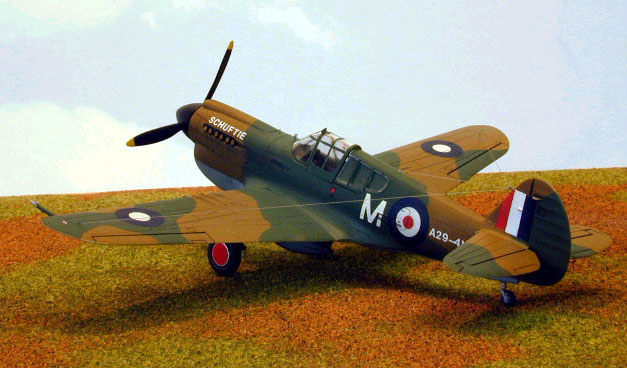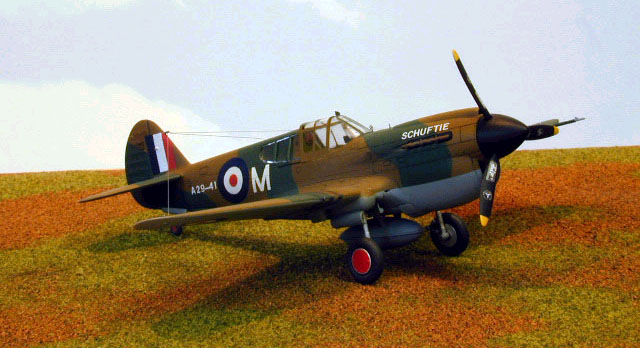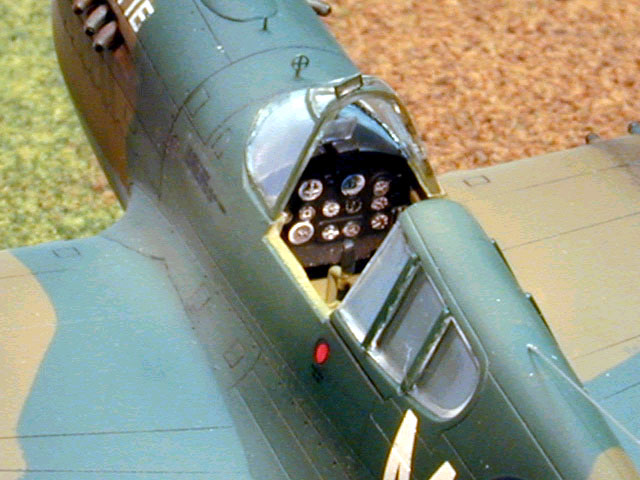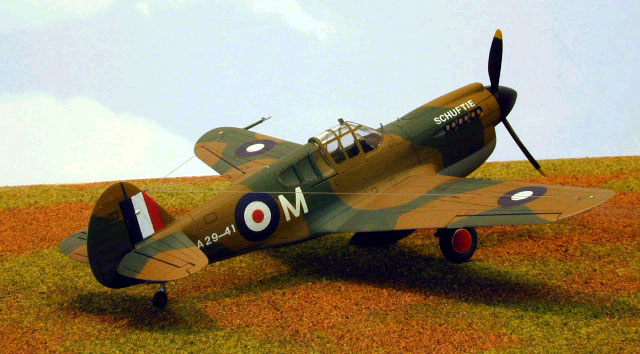|
Curtiss P-40E Kittyhawk
by Caz Dalton
|

|
|
Curtiss P-40E
Kittyhawk
"Shuftie" A29-41, 75 Sqn RAAF, Port Morseby |

Academy's
1/72 scale P-40E Kittyhawk is
available online at Squadron.com
Rather than go into a long history of the P-40 and its variants, I am
simply going to copy and paste the history of 75 Squadron as supplied by
Joe Amodea and Jorge Alsina in their absolutely superb "Combat Flight
Simulator 2 - War in the Pacific" add on, 75 Squadron RAAF - The Defence
of Australia - 1942, which can be downloaded for those of you that has
CFS 2 from Simviation - http://simviation.com/menu.html. It is a
wonderful addition to this flight simulator and everything goes in place
in a nutshell. Highly recommended.
One of the two flyable simulation planes spurred me to get the Academy
1/72nd kit and have a go at constructing "SCHUFTIE", my first source of
markings taken from a flight simulation aircraft. Please enjoy the
pasted article by Joe Amodea and Jorge Alsina, who have granted me
permission to use it for my article. It's quite long, but many of you
may enjoy this delightful and very historical read. Other references
used by Mr. Amodea Mr. Alsina are noted in the bibliography.
The Early
History of 75 Squadron RAAF
|
75 Squadron was for Australia, together with the small garrison at Port
Moresby, virtually the only forces in theater to prevent the Japanese
advancement in New Guinea. It was suspected at the time and later
confirmed, that the Japanese had planned to stage an invasion of the
Australian homeland from an anticipated stronghold in New Guinea.
The history of 75th Squadron RAAF is one of magnificence, bravery and
honor, with many pilots risking - and sometimes sacrificing their lives
for their country. They flew with a numerical disadvantage against
first-rate enemy pilots as those in the Tainan wing and with the best
Japanese aces as Sakai, Ishizawa, Ota, Honda, among many others.
Shortly after some US P-40E were available in Australia, in February
1942, 75th Squadron was formed in nine days at Townsville, Australia,
furnished with some experienced pilots taken from the North Africa
front, as well as newly trained pilots. On March 19th, Squadron Leader
John F. Jackson was appointed as the Commanding Officer of 75 Squadron
RAAF.

On March 19th, 17 Kittyhawks left Townsville, via the RAAF base at Horn
Island and then in a second flight up to Seven-Mile airfield in Port
Moresby. The Australian garrison detached there, gave them a heated
reception as the garrison attacked the oncoming first fighters with
flak. Three fighters were damaged, fortunately with no injuries to their
pilots. One hour after landing, a general alarm was sounded and the
daily Japanese reconnaissance aircraft was intercepted and shot down.
After this, the contrite Garrison morale was greatly improved.
The Squadron experienced intensive fighting from that day through May
3rd, when the extreme attrition on their equipment and the fatigue of
the survivor pilots called for a well deserved rest in a rear area. At
that time US 8th PG was taking their turn at combat in New Guinea.
The 75th ended its Port Moresby campaign just at the beginning of the
Battle of the Coral Sea. They had opposed seemingly continual hordes of
Japanese bombers and fighters, which were in fact preliminary softening
actions prior to the planned Port Moresby invasion.
After Port Moresby, the 75th was deployed for a deserved rest and
rebuilding to a rear area near Townsville, Australia only to return to
New Guinea to fight again in their aging Kittyhawks at Milne Bay in
August of 1942. The next year, they were back to Milne Bay with improved
P-40N or Kittyhawk IV aircraft where they would support an offensive by
Australian ground forces and participate in the repulse of the landing
there by the Japanese.
Historical
Background on
the Southwest Pacific Theater -
Papua and New Guinea Territories
The following narrative is included to provide a deeper context for the
campaign and to give the reader a glimpse at the events that occurred
after the action of this campaign. It is not meant to be exhaustive. An
historian or avid history buff may be offended by the sins of omission.
However, the authors do provide a bibliography and we certainly mean to
encourage you to go explore this subject in greater depth.
The action of the 75th defense of Port Moresby really marked the
beginning of a long struggle between the Allied forces newly organized
under the command of General Douglas MacArthur – fresh from his
then-recent defeat in the Philippines – and the firmly entrenched and
dominant forces of the Imperial Japanese Navy and Army based not only in
New Britain, but also along the northern and western stretches of New
Guinea itself. Eventually, there were strongholds not only at Lae but
also at Salamaua, Buna, and Hollandia and later at Wewak.
Ultimately, it took more than two years for the Allies to dislodge the
Japanese and the common enemy for both sides was the jungle itself. In
the fighting that ensued, the terrain dictated that much of the fighting
was small arms combat supported by air actions. The U.S. army
experienced its highest rate of casualty due to neuropsychiatric
disorders, nearly 44 men per 1,000 under arms. In New Guinea, ambush and
sudden death were commonplace. In the Southwest Pacific, small arms
claimed 32% of Americans killed in action versus 17% by artillery fire.
This is in contrast with the numbers for the war as a whole where
overall rates were 19.7% for small arms fire and 57.5% for artillery
fire.
The Allied air forces were under the command of Major General George C.
Kenney and the Fifth Air Force. The struggle for control of the air
resulted in the loss of 1,374 Allied aircraft between September of 1942
(after the action of our subject project) and September of 1944. During
this time period, approximately 4,100 American airmen and more than
2,000 Australian airmen were either killed or listed as missing in
action. There were over 24,000 battle casualties and over 70% of these
(17,107) were Australian. Malaria casualties alone numbered 70,000.
During this same period, over 110,000 Japanese soldiers and airmen lost
their lives to fighting, disease and starvation.
So why such a big disparity in the numbers?
It is the conclusion reached by author Edward J. Drea, that the Allies
and especially General MacArthur and General Kenney, General Walter
Krueger and Admiral Arthur Carpender and Admiral Daniel Barbey
collectively realized a fundamental truth. The terrain of New Guinea was
so hostile to ground warfare that a new strategy had to be discovered.
As it turns out, MacArthur developed a risky but effective tactic of
bypass. His subordinates developed and honed the rapid amphibious
assault, but not frontally - rather in a series of flanking actions.
Of course it helped that the Japanese left a trunk behind with their
ciphers available to the Allies and many of the strengths and weaknesses
of the Japanese forces were known in advance!
And then the Japanese upper command hung onto a stubborn belief that a
ground war could be fought in New Guinea. There were a number of
ill-conceived campaigns to attack allied positions by cutting their way
through the unforgiving terrain. They nearly succeeded a couple of
times. But “nearly” wasn’t good enough. In one action – in an attack at
the Australian base at Wau, they were turned around by the last minute
arrival of C-47 transports with men jumping out weapons blazing while
the props were still turning!
Many Japanese troops were lost in the jungle to disease and starvation
after their retreat from coastal positions having been driven out by
Allied amphibious action and close air support.
"The high mountain peaks and deep gorges, covered with thick jungle
vegetation make passage overland by large units nearly impossible. The
lee of the mountainous spine around the Port Moresby area is wet from
January to April, but otherwise dry. On the windward side, scene of most
of the ground fighting from 1942-1945 rainfall falls as high as 150,
200, or even 300 inches per year. As one veteran recalled, "It rains
daily for nine months, and then the monsoon starts.""
The enemy included malaria, dengue fever, dysentery and a host of other
diseases. "Men ate their rations with one hand using the other to flick
away clouds of black flies that swarmed to the food."
Eastern New Guinea, New Britain, New Ireland, and the surrounding
archipelago were all Australian protectorates, the western half of New
Guinea being a Dutch protectorate.
It was in January of 1942 that the Japanese kicked off their plan of
conquest by capturing Rabaul in New Britain. They killed about 300 of
the Australian defenders and imprisoned the balance of the original
1,200 in this nominal force under cruel conditions. At this time, the
Japanese put into affect the "FS" operation aimed at isolating Australia
by capturing Port Moresby and establishing forward bases in the Solomons.
The earliest part of this operation was to set up a base at Lae and
Salamaua.
There was an unopposed 3,000 man amphibious landing at Lae on March 8th,
the Australians having seen this coming and having withdrawn to Wau in
the Bulolo valley.
100 aircraft from Lexington and Yorktown caught the Japanese by surprise
and sunk 11 transports and killed or wounded about 400.
At this time, however, the Allies had no significant troop
concentrations in this area and very little in the way of equipment as
well. What was there was spread very thin.
The Australians had just recalled their 6th and 7th Divisions from North
Africa and the U.S. sent the 41st and 32nd Infantry to Australia.
This month of March was the same month that MacArthur fled the
Philippines, vowing to return. This was the beginning of the period of
the campaign we call: “In Defence of Australia – 1942.”
Bibliography
For historical background concerning the entire Pacific war, a good
source is:
- War in the Pacific – Pearl Harbor to Tokyo Bay edited by Bernard
C. Nalty, Technical Advisor Russ A. Pritchard
Perhaps the best source of technical information about U.S.
manufactured aircraft:
- America’s Hundred-Thousand – U.S. Production Fighters of World War
Two by Francis H. Dean
Many thanks go to Joe Amodea and Jorge Alsina for permission in using
the historical background their CFS 2 add on program.
This is Academy's 1/72 scale P-40E.
Interior
What can I say, once again Academy delivers. The cockpit of this kit is
superb, lacking only seat belts and harnesses, which I printed on
premium inkjet paper and coated both sides of the paper printed belts
and harnesses with Microsoft Super Film. This keeps the printed items
from fraying when one cuts them out, for which I used very sharp sewing
scissors and an X-Acto #11 blade for finishing work, if required. The
Super Film also more or less makes a decal out of the print. I apply a
smidgen of Elmer's Glue thinned a bit in with water and applied them as
one would a decal.

The cockpit was painted Polly Scale Interior Green and the instrument
panel semi-gloss black. Black boxes were hand brushed in semi-gloss
black and various Reheat Models Vintage Control Placard and Data Placard
decals were applied over the back boxes. The instrument panel was done
using Waldron-punched disks of white decal trim film first. This
received a coat of clear gloss after drying to insure they would not
lift up upon the application in the decal gauges, in which I used Reheat
Models Instrument Gauges in 1/72 scale. The cockpit received an ink wash
to shadow the crevices and highlight the raised sidewall detail. The
gunsight is clear and when the casing is painted semi-gloss back, it
looks very good. Unfortunately, the clear reflector had a mold line down
the center, which I scraped with the backside of a #11 blade and coated
with FUTURE. It would be nice if all kit manufacturers would do their
molds so that the seam is in the middle of the casing and not on the
reflector, but that's a minor nit pick. Most often I cut the reflector
off and replace it with a cut piece of 0.010 clear sheet styrene, but I
wanted to keep this kit out-of-the-box, so I left the reflector as is.
Exterior
As it turned out, this model was doomed for an out-of-the-box
competition! I lost one of the main gear doors to modeling heaven and
had to find a substitute. What I found looked so much better than the
solid molded kit doors, that I used it for both doors. These were very
easily made using cut sections of half-round 0.125 inch (inside
diameter) styrene tubing found in my trusty model railroad shop. I
recommend this to all for use should you decide to build this kit. Since
I took it out of the OOB territory, I decided to add the photoetch ring
sight pieces and the photoetch rear-view mirror. Unfortunately I had
cemented the forward canopy windshield and did not risk taking the
gunsight off and replacing the reflector.
The main wheel and tail wheel were painted Polly Scale Grimy Black and
the gear struts paint PS SF Silver. The wheel centers for the main
wheels were done with Bare-metal foil and the red painting of the outer
half of each wheel done with a circle cut from red decal trim film. All
received a coat of Polly Scale Clear flat to seal and knock the shine
off of the Bare metal foil. The interior of the wheel bays and gear
doors were painted PS Interior Green and given an ink wash to shadow and
highlight.
The radiator and oil coolers were painted Polly Scale SF Silver (a model
railroad paint) and given an ink wash in the screens. The interior of
the fuselage around this area and the splitter piece were paint Polly
Scale US Medium Gray. The separate exhaust pieces were first painted
flat black, then brush painted with Gunze Burnt Iron, followed by a wash
of Pactra Rust Acrylic. I had previously drilled out the exhaust
openings with a #79 bit. The backing plate for the exhausts on each
piece was left flat black. The propeller spinner and backing plate were
painted flat black and the propeller semi-gloss black. The yellow
propeller tips were first done in cut pieces of yellow decal trim film.
Since yellow is so translucent, I brush painted a coat of Polly Scale
Reefer yellow (model RR paint again) over each decal and all worked
well. Kit decals for the prop logo and stenciling were used, but for
some reason, the stenciling silvered badly. I wish I had used an
aftermarket sheet with these instead, as I did not use any other kit
decals other than the black stenciling for the fuselage and wings, these
going on and not silvering, so I do not know the reason for the prop
stenciling problem.

Fit of the main assembly was as good as it gets. I had absolutely no
filling in the fuselage or wing half joins, none to the wing to fuselage
join, and the horizontal tails fit so well, I did not attached them
until final assembly. Even then I only used a smidgen of styrene cement
in the slots and filled the seam lines with Microsoft Kyrstal Kleer. If
you've never tried Krystal Kleer as a filler, give it a go, it has very
good adhesive properties and doesn't shrink like Elmer's. It may require
a brush touch up once dry to remove the gloss, but most often I simply
apply a finish coat of flat and that will do the trick. The molded in
wing guns were excellent and all I did was drill out the barrels with a
#80 bit. I think this is only the second model I have done recently,
where I didn't have to replace the guns with hypodermic tubing. The
aerial wiring is done using smoke colored invisible thread and attached
to locations shown in the flight simulation plane and was applied in the
final assembly.
After masking the canopy pieces with Bare-metal foil, I painted them PS
Interior Green. The forward windshield was permanently attached with
Model Masters Clear Parts Cement and the center sliding section attached
temporarily with two strips of double-sided Scotch tape. The rear
transparencies were painted separately and applied in the final
assembly. All pieces fit super, but I wish Academy had included a
slightly larger center section that would fit when slid back. The rears
glazings seem to have rather oversized bracings, but since the center
section would not fit anyhow, I left them as molded. Clarity of the
clear parts were up to the standards of the industry.
Wheel bays, the interior of the gear doors, and front intake and
coolers were masked with medium tack masking tape and the entire model
primed in Polly Scale Medium Gray, which closely matched the color
requires for RAAF aircraft in this theater of the war. I think it was
called Sea Grey (UK spelling).
Once I had done a little light sanding of the primed surfaces and
reprimed any sand through, I masked the undersurfaces and sprayed the
tops with Polly Scale Earth. I ran off some screenshots of "SCHUFIE"
showing the wings, horizontal tails, and both fuselage sides. Next I
reduced the screenshots to the model scale and printed two of each. From
these I cut paper templates for the camouflage pattern and cut out those
to remain Earth. These were applied with cut strips of two-sided Scotch
tape, applied just slightly inwards of the edges, but not until I had
reduced the adhesive to that of a medium tack. Transitions of the paper
masks to the leading and trailing edges of the wings and horizontal
tails were done with medium tack masking tape. Once done, I sprayed the
uppers with Polly Scale Foliage Green. All masking was removed from the
lower surface, but left in place on the intakes, coolers, and gear bays.
The model then received two light coats of Polly Scale Clear Gloss for
decal prep.

Decals were used from three old 1/72 scale Superscale sheets for
World War II British aircraft roundels and fin flasks. All lettering and
numbering were done using a Microscale sheet for HO (1/87 scale)
railroad cars. Each had to be cut and applied individually.
Once the decals had dried, I applied two light clear coats of gloss to
seal the decals. After a day, I applied two light coats of Polly Scale
Clear Flat and commenced with the final assembly and a little light
weathering. The cordite gun stains were done using a small stipple brush
and black powdered pastel chalk. The exhausts received a bit of stain
using both black powdered and medium gray pastel chalk.
Now I have a miniature of an airplane that I can also fly. Well, sort
of...
Model, Text and Images Copyright © 2001 by
Caz Dalton
Page Created 19 August, 2001
Last Updated 04 June, 2007
Back to HyperScale
Main Page
Back to Features Index |
Home
| What's New |
Features |
Gallery |
Reviews |
Reference |
Forum |
Search